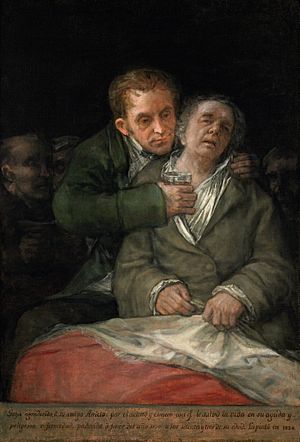Self-portrait with Dr Arrieta facts for kids
Quick facts for kids Self-portrait with Dr Arrieta |
|
|---|---|

Inscription (bottom of canvas in brown): Goya agradecido, à su amigo Arrieta: por el acierto y esmero con g.e le salvò la vida en su aguda y peligrosa enfermedad, padecido à fines de año 1819, a los setenta y tres de su edad. Lo pintó en 1820.
|
|
| Artist | Francisco de Goya |
| Year | 1820 |
| Medium | Oil on canvas |
| Dimensions | 114.62 cm × 76.52 cm (45.13 in × 30.13 in) |
| Location | Minneapolis Institute of Art, Minnesota |
Self-Portrait with Dr Arrieta is a famous painting by the Spanish artist Francisco Goya. He painted it in 1820 using oil paints on a canvas. This artwork is now kept at the Minneapolis Institute of Art in Minnesota, USA. The painting shows Goya himself, looking very sick, being helped by his doctor, Eugenio García Arrieta. It is a powerful image of gratitude and survival.
Contents
Goya's Health Struggles
Francisco Goya faced serious health problems throughout his life. These illnesses greatly influenced his art.
First Illness and Deafness
In 1792, Goya became very ill. He experienced dizziness, weakness, and pain. He also lost his hearing and could not see well for a time. By 1793, when he returned to Madrid, Goya was completely deaf. Doctors have suggested many possible reasons for this illness. These include lead poisoning or other serious infections. This first illness changed Goya's life and his art forever.
A Second Serious Illness
In 1819, Goya became very sick again. He was 73 years old at the time. Not much is known about this illness. However, we know that Dr. Eugenio García Arrieta took care of him. Goya likely thought he might die from this sickness. But thanks to Dr. Arrieta's care, Goya got better. He lived for another eight years after this.
A Painting of Thanks
Goya painted Self-Portrait with Dr Arrieta to show his deep thanks. It was a gift to Dr. Arrieta for saving his life. The painting shows Goya looking weak and unwell. Dr. Arrieta is shown supporting him, offering medicine. It is a very personal and emotional artwork. It is not clear how long Dr. Arrieta kept the painting. He traveled to Africa in 1820. The painting probably stayed in Spain. Later, it was owned by different art collectors before finding its home in Minneapolis.
Why This Painting Is Important
Self-Portrait with Dr Arrieta is a very important painting for several reasons. It shows a big change in art and in Goya's own style.
A New Kind of Portrait
This painting helped change how portraits were made in Spain. It moved away from very formal, traditional portraits. Instead, it showed a real, raw moment of human weakness and care. It also showed a shift towards more everyday, non-religious subjects in art.
Goya's Changing Self-Portraits
The painting also shows how Goya's view of himself changed. Before his illnesses, Goya drew himself as young and full of life. He used clear lines and strong shadows. But in Self-Portrait with Dr Arrieta, he shows himself differently. His jaw hangs open, and his body looks weak. This artwork helps us understand how Goya's experiences affected his art. It shows his journey through sickness and recovery.
Themes of Hope and Healing
Goya often explored big ideas in his art. These included sadness and hope, or destruction and salvation. Self-Portrait with Dr Arrieta fits into these themes. It shows a moment of great weakness and closeness to death. But it also offers hope. It shows the possibility of healing and survival. It reminds us that even in dark times, there can be light and recovery.
See also
 In Spanish: Goya a su médico Arrieta para niños
In Spanish: Goya a su médico Arrieta para niños
- List of works by Francisco Goya
Sources
- www.ncbi.nlm.nih.gov – The fine art of patient-doctor relationships
- John J. Ciofalo. "The Artist in the Vicinity of Death." The Self-Portraits of Francisco Goya (Cambridge: Cambridge University Press, 2001)

